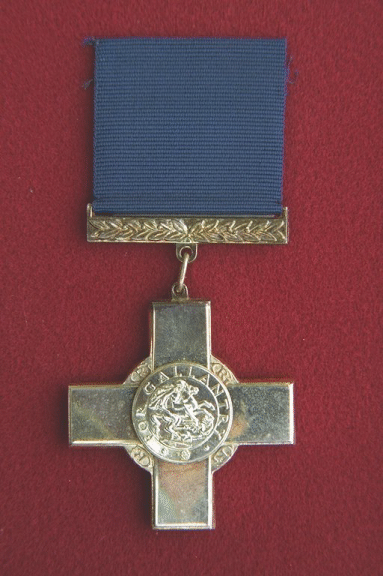George Cross (GC)
Description
Context
The George Cross (GC) was created on 24 September 1940 and published in the London Gazette on 31 January 1941.
Eligibility and Criteria
The cross was awarded for an act of the greatest heroism or of the most conspicuous courage in circumstances of extreme danger. It was intended primarily for civilians and award in the military services was confined to actions for which purely military honours were not normally granted and actions not in the face of the enemy.
The Empire Gallantry awards were exchanged for the GC, and in 1971, Albert Medal winners exchanged their medals for the GC.
Description
A silver Geneva Cross, 1.8 inches wide.
On the obverse, in the centre of the cross is a circular medallion showing St. George slaying the dragon and around this an annulus bearing the legend FOR GALLANTRY. On each limb of the cross, the Royal Cypher GVI forming a circle concentric with the medallion.
The reverse is plain except for the naming.
The garter blue ribbon is 1.5 inches wide. A miniature cross is worn on the ribbon in undress. Women may wear their cross from a bow.
Bars
A bar was to be awarded for additional acts of gallantry; none were ever issued.
Historical Notes
- The name, rank and service number (serial number for those not commissioned) and the date of notification in the London Gazette are shown on the reverse of the cross.
- There have been ten crosses awarded to Canadians; eight military, one Merchant Navy, and one civilian.
- Recipients:
- ASHBURNHAM-RUFFNER, Doreen (Converted from Albert Medal)
- BASTIAN, Gordon (Converted from Albert Medal)
- FROST, Ernest (Converted from Emperor Gallantry Medal)
- GRAVELL, Karl, Royal Canadian Air Force (RCAF)
- GRAY, Roderick, RCAF
- HENDRY, James, Canadian Army
- PATTON, John, Canadian Army
- RENNIE, John, Canadian Army
- ROSS, Arthur, RCAF
- SPOONER, Kenneth, RCAF
